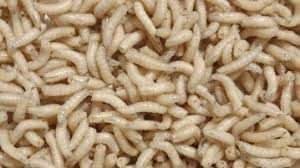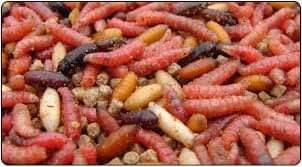FEEDING OF MAGGOTS TO BACKYARD POULTRY AS A SOURCE OF PROTEIN
Maggots a good source of protein for organic poultry
Maggots and maggot meal have proven to be a good alternative to fish meal in organic poultry. This is the results of experiments carried out in the project BioConval, which is supported by the International Centre for Research in Organic Food Systems (ICROFS).
The lack of a locally grown protein feed with a sufficiently high content of sulphur-containing amino acids is a major challenge for organic poultry production. Since synthetic amino acids are not permitted in organic production, organic poultry producers rely on animal protein sources with a favourable amino acid profile such as fish meal. But fish meal is a limited resource and therefore it is important to find alternatives.
The BioConval project had a twofold purpose. It was partly an experiment on composting that studied the feasibility of improving the plant-available nutrient content in poultry manure and partly a feeding experiment examining whether the maggots (Musca domestica) that formed part of the composting process could be harvested and used as a protein feed.
Aarhus University supported an experiment with organic growers where growth was studied by comparing feeding regimes with either live maggots and maggot meal or with fish meal and the effect on the birds’ intestinal health and behaviour.
The study included 450 day-old growers (Hisex white). They were divided into three groups that over a period of eight weeks were fed three diets with different protein sources: fish meal, maggot meal or maggot meal plus live maggots. The allocation per chicken per day was 2-3 g live maggots. Chicken weight and feed consumption were recorded every two weeks.
At the end of the experiment, an individual fear test was performed on the chickens.
Less fear in chickens
The experiment also showed that the growth rate resulting from a diet containing maggot meal is fully on par with that of fish meal, and maggot meal is therefore a good alternative protein source in organic production.
The chickens relished the maggots, and the group fed live maggots achieved the highest growth rate. They ate roughly 6 g less of the mixed feed per day, although they were only allocated 2-3 g fresh larvae. The fear test also showed that the chickens were less fearful than the chickens in the two other groups. Live maggots can consequently be regarded as a promising feed ingredient both nutritionally and particularly in terms of welfare. However, there is always some risk of infection associated with the use of maggots from manure. There is therefore a need to develop a suitable sanitising method that can minimise this risk.
Housefly maggot meal
Description
The housefly (Musca domestica Linnaeus 1758) is the most common fly (Diptera) species. It is a worldwide pest and a major carrier of diseases, as both the larvae (maggots) and the adult flies feed on manure and decaying organic wastes. The ability of housefly maggots to grow on a large range of substrates can make them useful to turn wastes into a valuable biomass rich in protein and fat. Producing housefly maggot biomass in controlled conditions to feed farm animals has been investigated since the late 1960s (Calvert et al., 1969; Miller et al., 1969). Particularly, housefly larvae grown on poultry litter have shown to be used with great benefits as a potential protein source in poultry nutrition (Pretorius, 2011). The use of housefly maggots to feed fish and crustaceans in pond farming has been studied extensively since the late 2000s. Other Musca species have been investigated to a lesser extent, such as the face fly Musca autumnalis (De Geer) (Koo et al., 1980).
Life cycle
Under natural conditions, housefly eggs hatch after 8 to 12 hours. The larval stage lasts about 5 days and the pupal stage 4 to 5 days. This 10-day cycle can be shortened to 6 days under controlled conditions. Adult female flies lay 500-600 eggs under natural conditions and more than 2000 eggs under controlled ones. The flies lay eggs in moist substrates such as manure and garbage heaps. Maggots feed for 4-5 days and then migrate to pupate in a dry place. The adult fly feeds mainly on decaying organic matter. It needs to liquefy the food by regurgitating droplets of saliva, thereby transmitting pathogens. The flies mate and lay eggs between feeding periods. Large populations of flies can be obtained from relatively small amounts of substrate: for instance, 450 grams of fresh manure can feed 1500 maggots (Hardouin et al., 2003).
Production
Various methods for producing and harvesting maggots have been described in the literature. Early experiments investigated pupae rather than larvae because pupae collection was believed to be easier (Calvert et al., 1969), but these technical issues have since been solved. Poultry manure is the most common substrate cited in the literature for housefly rearing (Hardouin et al., 2003; Akpodiete et al., 1997), sometimes using a fly attractant like animal offal or rotten fruit (Odesanya et al., 2011). Other substrates mentioned in the literature include: pig manure (Viroje et al., 1988; Zhu et al., 2012); cattle blood and wheat bran (Aniebo et al., 2008); cattle blood and gut contents (Dankwa et al., 2002); cattle gut and rumen contents (Ekoue et al., 2000); fish guts (Ossey et al., 2012); and a mixture of egg content, hatchery waste and wheat bran (Ebenso et al., 2003). Usually the technique involves filling tanks or crates with manure sprinkled regularly with water to keep the manure wet and attract the flies. A moisture range of 60 to 75% is suitable for larval development. Temperatures should be in the 25-30°C range since maggots are inactive and develop poorly at temperatures below 20°C (Miller et al., 1974).
Maggots are harvested by several methods. In the flotation method, the manure is mixed with water and the larvae and pupae float out to be collected with a sieve. In the screening method, the manure is spread in a thin layer on a sieve (3 mm) placed over a basin under sunlight: the larvae try to escape the light by passing through the screen and fall into the basin (Sogbesan et al., 2006). The collected larvae are washed, killed in tepid or hot water and then dried and milled. More sophisticated collection methods that make the larvae self-collect have been designed (El Boushy et al., 1985).
Distribution
Houseflies are a common species worldwide. However, optimal production of maggots requires warm temperatures (over 25°C) and moisture.
Processes
Most trials have been done with sun-dried (or oven-dried) and ground larvae. There have been some attempts at defatting or hydrolyzing the maggots (Fasakin et al., 2003). Housefly maggots can be also be fed live, especially to backyard chickens (Dankwa et al., 2002; Ekoue et al., 2000) and fish (Ebenso et al., 2003; Madu et al., 2003).
Environmental impact
Housefly larvae are able to break up and dry out large amounts of poultry manure, and this ability makes them a potential solution to waste management in poultry farm.
PREPARATION OF MAGGOTS STEPS:
STEP 1
Get any plastic open container. Size should be according to quantity of maggots you want to make.
STEP 2
Get any substrate that are non smelly like Rice bran, wheat offal, pkc, maize shaft from akamu, cassava shaft. These materials serves as bedding and substrate for the flies to lay their egg
STEP 3
Mix some quantity of water with sugar or molasses allow the mixture to stay for 24hours covering it in a cool dry place.
STEP 4
Mix this water mixture with any substrate you have chosen till it forms a mesh don’t water log the substrate…And leave the plastic containing the substrate in an isolated place so no much disturbance
STEP 5
After 3 days you will notice lots of flies around the plastic containing the substrate, but before then make sure daily you wet the mixture by sprinkling water to make the content so it remain in a mesh form.
Note -once the content is dry.. Flies will only eat from the substrate and not lay eggs. This will cause the system to produce very little or no maggots.
STEP 6
After 5 days you will notice lots of white clutches of materials at different part inside the mesh mixture this are flies eggs at beginning of day 6. Close up the open part of the plastic with a mosquito net so that nothing goes in or out of the system, while sprinkling of water daily is important.
STEP 7
Remember that the plastic should be kept in a cool place some level of shade like under a plantain or banana trees or any trees that form some level of SHADE, to avoid direct sunlight heating up the system, which could mess it up.
Step 8
Harvesting can start from day 7 till day 12 depending on the size of fish or animal you want to feed them with you can harvest by getting salt in warm water in a bucket; usually maggot will stay under the layers of the substrate so use a Parker to get out the first layer.
Then get the maggots with the substrate and pour them in a different container, containing warm water and salt.
NB
From day 6, you will start to notice lots of maggot formation though small in nature
To make them big you can sprinkle little bakers yeast ,it grows them faster
Though if you don’t have the maggots will feed on the substrate.
STEP 9
Maggots will float up and the substrate will sink down you can use a sieve to separate the maggots from the water.
Step 10
Maggots can be fed live to animals like fish, poultry etc
Or they can be sun dried , grounded and mix with your feed formula remplacing costly soya thereby reducing cost of your feed and still having high quality feed at less cost. Live maggots are about 38 percent crude protein and dry maggots are 40 to 45 percent cost depending on which substrate you use.

Reference-Dr Surinder khanna.


